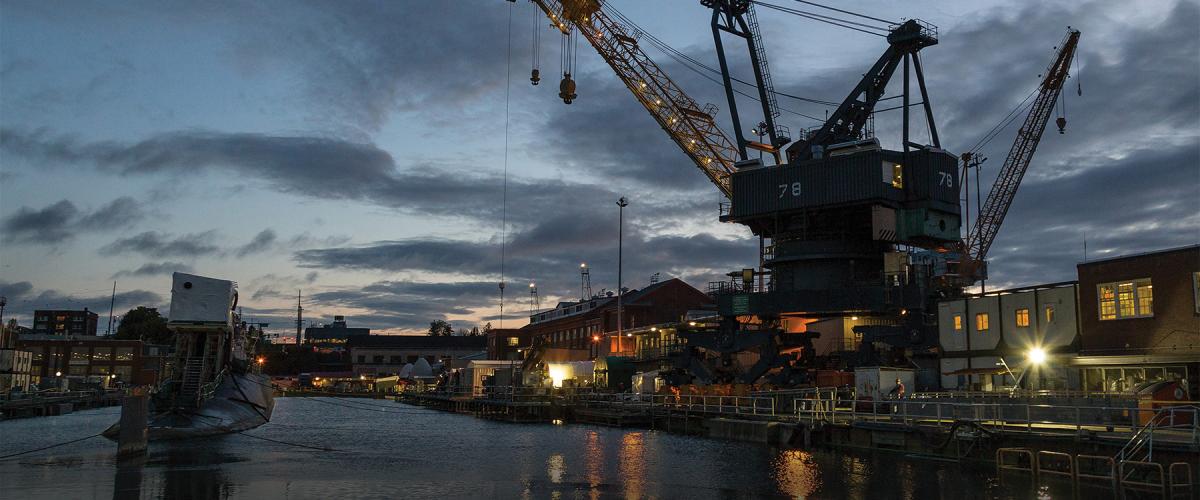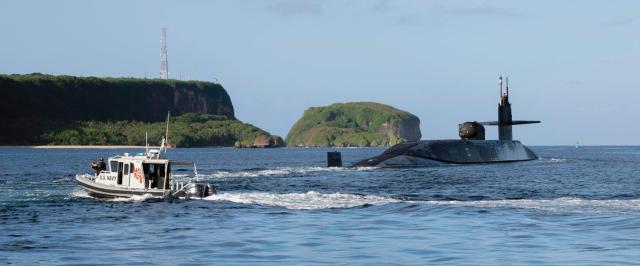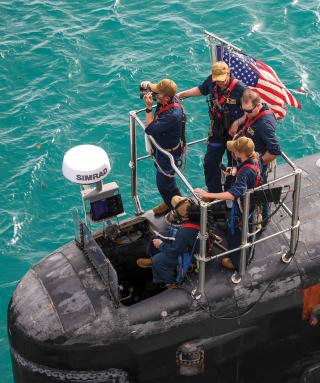The submarine force devalues the experience of shipyard junior officers whose mission has been returning warships to fighting shape. These junior officers spend their days in shipyards laboring over work controls and complex maintenance procedures to the detriment of their navigation and tactical prowess. They are at a disadvantage because they spend less time at sea honing their skills on the tip of the Navy’s lethal spear.
A Shipyard Problem
While assigned to a submarine undergoing major overhaul in a shipyard, junior officers often view the best part of their tour as the qualification ride on another deployed boat executing a demanding and rewarding mission, instead of their time in the shipyard managing the work on their parent submarine. Of course that is their favorite experience, because that is what they signed up to do when they joined the submarine force. It is why they spent two years in pipeline training, including hundreds of hours in shore-based trainers. Junior officers are trained to drive and fight their submarines and operate nuclear reactors at sea. In fact, unrestricted line officers receive no formal training in the submarine warfare pipeline on work controls or material management of a ship undergoing overhaul. Nor do they see much enthusiasm in their senior leaders about taking a submarine through an overhaul, compared with the appeal of deployments and missions.
The shipyard problem directly affects the careers, readiness, and lethality of young warfighters and is contrary to the imperative in Chief of Naval Operations Admiral Michael Gilday’s Navigation Plan to develop seasoned teams of naval warriors. Often, junior officers talk about their time in the shipyard as a big deception, as they believed they would be tactical contact managers and officers of the deck, stalking the ocean’s depths and executing national tasking. The average length of time a submarine spends in a shipyard per year is growing, and submarine junior officers spend too much time organizing work controls and coordinating maintenance, which detracts from their readiness as unrestricted line officers.
Refueling and Overhaul
Before 2011, a refueling overhaul for a ballistic-missile submarine was executed in 27 months. Since 2011, a refueling takes 32 months or more.1 From 2015 to 2019, 75 percent of all submarine availabilities were completed late, with an average of 225 additional days. Compounding the problem, idle time before or during maintenance availability increased from 100 days in 2015 to 1,019 days in 2019—an increase of more than 900 percent.2 In comparison, the average junior officer’s sea tour is 32 months, meaning an officer detailed to a refueling boat could have his or her entire onboard experience eclipsed by an extended period in the shipyard.
In several extreme cases, submarine availabilities have been extended past 200–300 percent of the originally planned timeline because of growth work and private yard readiness for nuclear repairs. During this time, an entire wardroom of about 15 submarine warfare officers run the ship and maintenance schedule with shipyard repair managers. With a fleet of 53 attack submarines and 14 ballistic- or guided-missile submarines, the submarine force maintains about 80 submarine crews, with roughly 1,200 submarine officers on sea tours. In 2019, the submarine force experienced about 1,800 delay days (680 on ballistic and 1,120 on attack submarines).3
With the 1,800 delay days spread across 80 crews, each wardroom loses 22.5 days a year of at-sea experience. If each officer stands watch or works on qualifications for eight hours a day, an officer misses 180 hours of at-sea training in a year. In total, the submarine force lost 216,000 hours of at-sea operations across its officer corps.
The average Virginia-class submarine repair period is executed with about 25 percent delay days. Therefore, a 450-day planned repair period has 112.5 additional days of work and results in a total of 562.5 days. Junior officers can expect to spend 58 percent of their first tour in the shipyard, not at sea. In addition, the 112 delay days come at the cost of not performing an entire submarine mission. Training and certification cycles are maintained the same, so the cost of delays comes out of the submarine’s scheduled operational cycle for operations and missions.
Once a delayed repair period is complete, the affected submarine rejoins the fleet, but the operations it missed are either assigned to another submarine or not executed. Based on required cyclic repair timelines, a submarine that is returned late to the fleet does not necessarily have the same amount of expected operational time and may execute fewer missions and spend less time at sea than planned because of the next required maintenance. Overall, the shipyard production and repair problem must be decoupled from submarine warfare officer readiness and experience.
An Aggressive Overhaul
Submarine warfare community managers have implemented a creative solution to reduce the navigator billet on submarines undergoing a major overhaul. I suggest an even more aggressive and progressive overhaul of junior officer management within the submarine force. To start, the submarine force should reduce the required number of submarine officers on ships undergoing overhaul. In addition, shipyard tours for junior officers should be restricted to ten months, at which point they would be rotated to a similar-class operational boat. To supplement the rotation and reduction of junior officers on ships undergoing overhaul, limited duty officers (LDOs) and engineering duty officers who are formally trained in material readiness and project management should be assigned to those ships needing additional oversight and watchstanders.
To start, two nuclear-trained LDOs should be assigned to a boat undergoing a six-month or greater availability to join the wardroom as duty watch officers, quality assurance officers, and availability managers. The nuclear departments of aircraft carriers have a similar career path already in practice. Ideally, a nuclear-trained and submarine quality-assurance lieutenant, lieutenant junior grade, or ensign (prior-served nuclear enlisted) would support the ship and department heads, executive officer, and commanding officer by taking over quality assurance programs and performing the quality assurance officer reviews and audits. As those LDOs progress in their careers, they should become availability managers. Their experience in the shipyard environment would greatly improve understanding and execution of maintenance because of their familiarity with shipyard practices and would assist the transition of a ship from operations to maintenance. Further, their joining the crew would allow one or two junior officers to rotate to an operational ship.
Placing required rotations or time limits on junior officer shipyard experience would greatly improve the morale and at-sea experience levels of affected officers. First, it would separate the material condition of the boat and shipyard results from their career progression. Second, this option could be used as a tool for junior officers and submarine force leaders to manage career and life planning. Coordinating with their leaders, junior officers could elect to use their shipyard time at the beginning or end of their career, to support work-life balance and family planning based on when they want to plan around a deployment cycle. A junior officer could elect to extend his or her shipyard time and waive the rotation if desired. Of importance, the rotations should be centered on transferring junior officers to similar classes of ships to reduce differences in qualifications and training.
Overall, many junior officers do not continue their careers to the department-head level because of the lack of professional satisfaction the shipyard environment provides. Whether they have mission experience or yearn for the opportunity on their next boat, the opportunity to execute and develop their tactical skills and face the nation’s adversaries is often a deciding factor in whether junior submarine warfare officers continue their careers. The submarine force must take a hard look at the numbers based on scheduled availabilities, exceeded timelines, and unplanned days lost in port, and how they affect readiness at a human-resource level.
To maintain dominance in undersea warfare, the United States must ensure submarine officers and sailors develop and continue to maintain the world’s premier submarine fleet, which is best fostered at sea and on mission. The concentration of unrestricted line manpower should be forward deployed, constantly developing seamanship skills and honing submarine warfare tactics. If the submarine force makes these changes, it will undoubtedly continue to control the tactical advantage.
1. Jessie Riposa, Michael McMahon, James G. Kallimani, and Daniel Tremblay, Current and Future Challenges to Resourcing U.S. Navy Public Shipyards (Santa Monica, CA: RAND Corporation, 2017).
2. Government Accountability Office, Navy Shipyards: Actions Needed to Address the Main Factors Causing Maintenance Delays for Aircraft Carriers and Submarines (Washington, DC: Government Accountability Office, 20 August 2020).
3. Congressional Budget Office, “The Capacity of the Navy’s Shipyards to Maintain Its Submarines,” 25 March 2021 Report.









